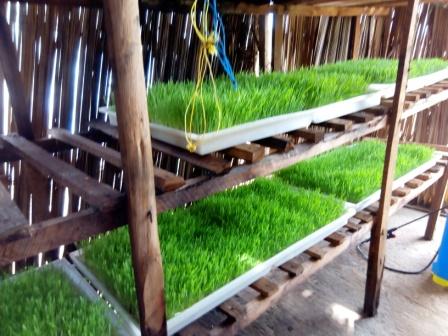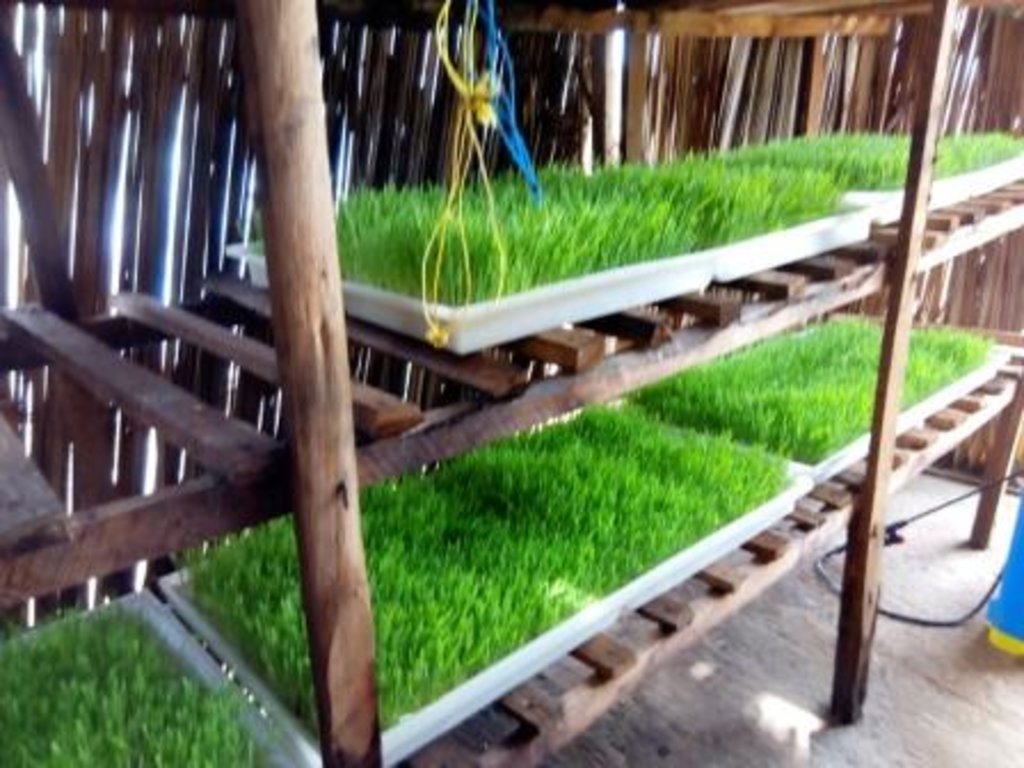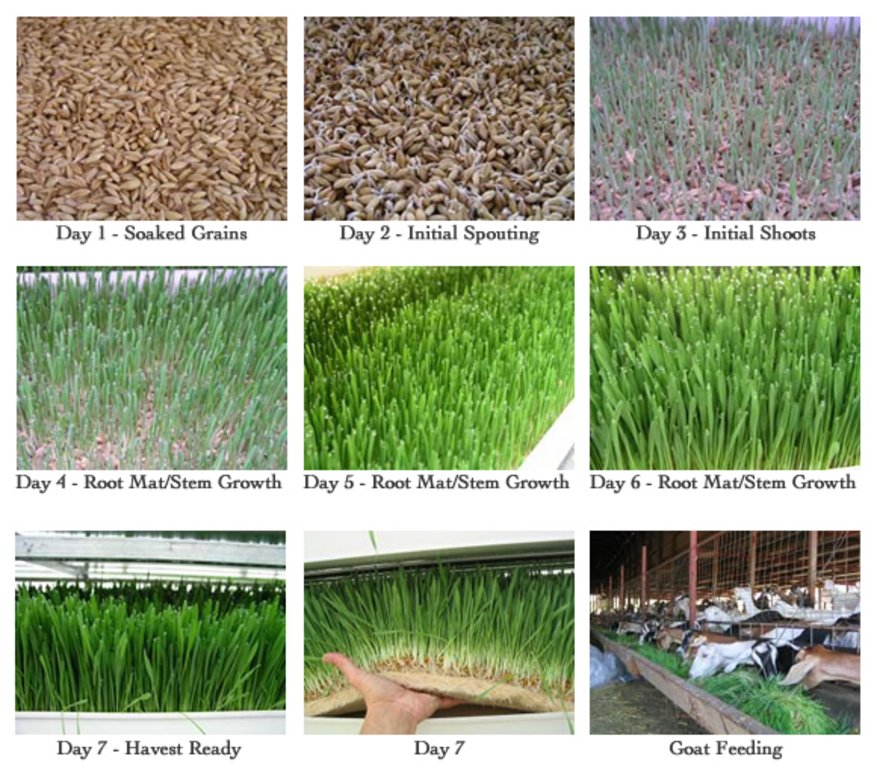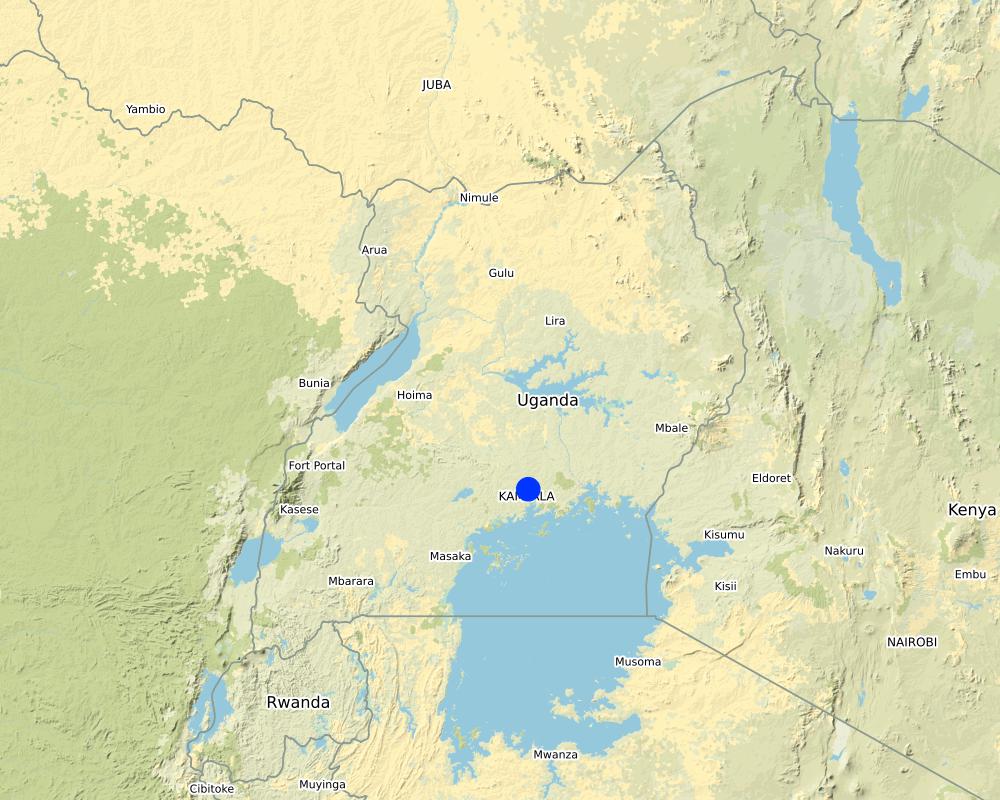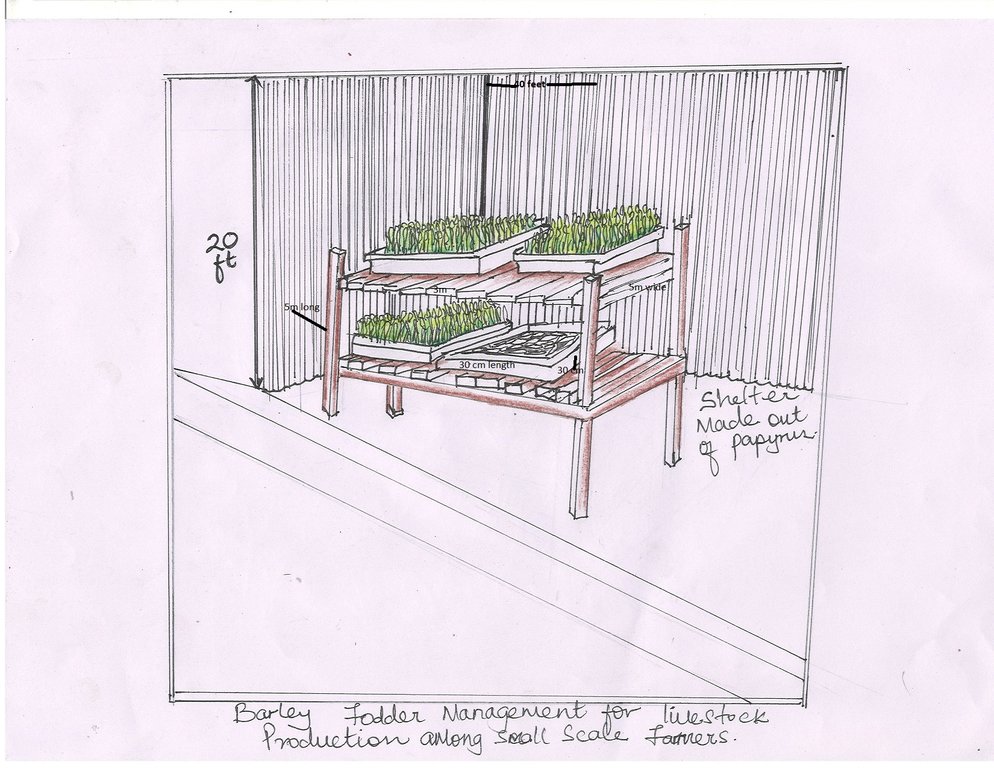Barley fodder management for livestock production among smallholder farmers [Ouganda]
- Création :
- Mise à jour :
- Compilateur : Sarah Babirye
- Rédacteur : Kamugisha Rick Nelson
- Examinateurs : Nicole Harari, Udo Höggel, Donia Mühlematter
Balle
technologies_3453 - Ouganda
Voir les sections
Développer tout Réduire tout1. Informations générales
1.2 Coordonnées des personnes-ressources et des institutions impliquées dans l'évaluation et la documentation de la Technologie
Personne(s)-ressource(s) clé(s)
Spécialiste GDT:
Kabanda Fred
0794661269
Kyanja Agricultural Resource Centre
Kyanja Agricultural Research Organizations Gayanza Road ,Parish P.O BOX 7010,KAMPALA
Ouganda
Nom du projet qui a facilité la documentation/ l'évaluation de la Technologie (si pertinent)
Scaling-up SLM practices by smallholder farmers (IFAD)Nom du ou des institutions qui ont facilité la documentation/ l'évaluation de la Technologie (si pertinent)
National Agricultural Research Organisation (NARO) - Ouganda1.3 Conditions relatives à l'utilisation par WOCAT des données documentées
Quand les données ont-elles été compilées (sur le terrain)?
29/1/2018
Le compilateur et la(les) personne(s) ressource(s) acceptent les conditions relatives à l'utilisation par WOCAT des données documentées:
Oui
1.4 Déclaration sur la durabilité de la Technologie décrite
Est-ce que la Technologie décrite ici pose problème par rapport à la dégradation des terres, de telle sorte qu'elle ne peut pas être déclarée comme étant une technologie de gestion durable des terres?
Non
Commentaires:
The technology is not problematic with regard to land degradation
2. Description de la Technologie de GDT
2.1 Courte description de la Technologie
Définition de la Technologie:
Barley fodder technology is a livestock feed that grows under a hydroponic system. This green feed is highly palatable, rich in protein and energy yet cost-effective. It takes few days to maturity (5-6 days) and can be grown in a smaller area. One kilogram of barley seeds can yield up to 6 to 6.5 kg of green feed.
2.2 Description détaillée de la Technologie
Description:
Barley is a cereal grain that grows with hydroponic system to supplement on the feeds for livestock. This system enables crops to grow without soil so easily yet they mature within the shortest time in a smaller area. It is commonly used in finishing rations for livestock. Barley sprouts the best, grows the fastest and is cost-effective. This green feed is less expensive yet highly palatable and nutritious for animals.
To work well for sprouted fodder, the barley seed needs a high germination rate. Sprouting barley consistently and economically needs a climate-controlled space, light (18 hours of light and 6 hours of darkness) and a watering system. The ideal temperature being 75 degrees F and 70% humidity. Air movement is necessary to control mold.
The technology ensures a reduction of pesticides and herbicides because the plants are in a protected environment . The sprouts are high in protein and fiber, and are naturally balanced in protein, fat and energy. Barley fodder has 95% of the energy and higher digestibility hence reducing the occurrence of digestive diseases, such as bloat. It is one of the most nutritious sprouts and is full of essential nutrients, vitamins and minerals. These are absorbed more efficiently due to the lack of enzyme inhibitors in sprouted grain. Dry barley seeds yields between 6-6.5kg of green feed. Feeding barley fodder will improve the overall health and wellbeing of animals. With this technology, farmers can easily anticipate the expected amount of feeds. Despite the benefits, growing barley requires skills, knowledge and constant supervision especially maintaining the conditions required. Barley seeds are at times hard to get. In case of commercial/large livestock farming, the technology is not economically feasible. Bacterial and fungal growth is also another challenge like the common bread mould therefore seeds must be sterilized. The steps taken to grow barley seeds are as follows:
•On day 1, the barley seeds are laid on plastic trays after being soaked in water for 8-12 hours or an overnight. These seeds must be moist and kept clean. In case of any moulds, hydrogen peroxide may be used in the soaking water to kill mould.
•On day 2, the trays are placed on shelves where they are stacked. On this day, initial sprouting begins. Seeds must be kept moist, but not water-logged. Manually, water should be spread every after 4-5 hours. The seeds will usually sprout within 24 hours.
•On the third day, initial shooting begins. Watering still proceeds.
•From the 4-5th day, the root mat or the mat stem begin to grow.
•On the 6-7 the day, the farmers begins to harvest the barley grass and gives to the livestock. The grass has produced a 6-8 inch high grass mat with a 2 inch mat of interwoven roots.
The sprouted grain is harvested by removing the tray or sliding the mat off the tray in one long sheet. The mats can be cut to the appropriate size and fed to animals. Livestock will eat the whole thing like seeds, roots, and grass therefore, there is minimal waste. Barley is a major feeding option when pastureland and/or hay are in short supply, or adds a highly nutritious and relished supplement to traditional grazing.
Initial costs involved to a small scale farmer are minimal. This includes buying clean seeds, 5 kg costing 15,000/=, 10 plastic trays (50000), 2 watering cans (20000), 1 bucket for soaking seeds (10000), watering seeds 6 times (18000), soaking seeds (3000), labour for making shelves (30000), papyrus mat (20000) ,2 kg of nails (10000), timber for making shelves (50000), chopping ready folder (3000) totalling to 232,000/= for a start. However, this depends on the amount of fodder a farmer wants to produce.
A kg of barley seeds yields to 7-10 kg of green fodder. Each kg of fodder is sold at 1500 hence in a kg planted (i.e. 3000 invested), a farmer is likely to earn 15000/=
The technology is advantageous in that there is little or insignificant costs involved on maintenance of the technology. Maintenance only involves daily watering of seeds (18000 for 6 days), cleaning the treys after use (3000) and supervision on barley during growing for 6 days (18000) totaling to 39000/=.
2.3 Photos de la Technologie
2.4 Vidéos de la Technologie
Date:
29/01/2018
Lieu:
Kyanja Agricultural Resource Centre
Nom du vidéaste:
Babirye Sarah
2.5 Pays/ région/ lieux où la Technologie a été appliquée et qui sont couverts par cette évaluation
Pays:
Ouganda
Région/ Etat/ Province:
KAMPALA
Autres spécifications du lieu:
Kyanja, Gayaza
Map
×2.6 Date de mise en œuvre de la Technologie
Si l'année précise est inconnue, indiquez la date approximative: :
- il y a moins de 10 ans (récemment)
2.7 Introduction de la Technologie
Spécifiez comment la Technologie a été introduite: :
- au cours d'expérimentations / de recherches
3. Classification de la Technologie de GDT
3.1 Principal(aux) objectif(s) de la Technologie
- améliorer la production
- créer un impact économique positif
3.2 Type(s) actuel(s) d'utilisation des terres, là où la Technologie est appliquée

Autre
Précisez:
Laboratory
Remarques:
The demonstration was done at Kyanja National Research Organization in a laboratory.
3.3 Informations complémentaires sur l'utilisation des terres
Approvisionnement en eau des terres sur lesquelles est appliquée la Technologie:
- mixte: pluvial-irrigué
Commentaires:
Water can be collected from national water (water supplied to people by the government of Uganda, National Water and Sewage Cooperation). Water from rainfall is be used in the process.
Précisez:
Not seseonal, can be grown any time
3.4 Groupe de GDT auquel appartient la Technologie
- gestion intégrée cultures-élevage
- perturbation minimale du sol
3.5 Diffusion de la Technologie
Spécifiez la diffusion de la Technologie:
- appliquée en des points spécifiques ou concentrée sur une petite surface
Commentaires:
Basically after building a structure with shelves, barley seeds are planted into trays.
3.6 Mesures de GDT constituant la Technologie

modes de gestion
- M2: Changement du niveau de gestion / d'intensification
Commentaires:
Barley seeds are cleaned before being planted to avoid the risks of fungal attack e.g moulds
3.7 Principaux types de dégradation des terres traités par la Technologie

autre
Commentaires:
Not applicable
3.8 Prévention, réduction de la dégradation ou réhabilitation des terres dégradées
Spécifiez l'objectif de la Technologie au regard de la dégradation des terres:
- non applicable
4. Spécifications techniques, activités, intrants et coûts de mise en œuvre
4.1 Dessin technique de la Technologie
4.2 Spécification/ explications techniques du dessin technique
The shelter is constructed at 20 feet long and 20 feet wide
Trays(10) of 30cm wide and 30 cm length
Barley seeds (5kg)
Shelves (20) of 3m wide and 3m long
Papyrus mats (2) of 20 feet wide and 40 feet long
Shelves stand of 5m long
4.3 Informations générales sur le calcul des intrants et des coûts
Spécifiez la manière dont les coûts et les intrants ont été calculés:
- par entité de la Technologie
Spécifiez le volume, la longueur, etc. (si pertinent):
20feet long*20feet wide
autre/ monnaie nationale (précisez):
UGX
Indiquer le taux de change du dollars en monnaie locale (si pertinent): 1 USD= :
3600,0
Indiquez le coût salarial moyen de la main d'œuvre par jour:
3000/= per day
4.4 Activités de mise en place/ d'établissement
| Activité | Type de mesures | Calendrier | |
|---|---|---|---|
| 1. | Buying seeds | Autres mesures | Every planting time |
| 2. | Clean the seeds if dirty to avoid molds | Modes de gestion | Before planting if they are dirty |
| 3. | Soak the seeds for 8-12 hours | Modes de gestion | 8-12 hours |
| 4. | Place the trays on the shelves | Modes de gestion | Once from 1-5 day |
| 5. | Water the seeds planted on the tray every 4-8 hours | Modes de gestion | 4-8 hours for 5 days after planting |
| 6. | Harvest and chop the leaves,stems and roots,then give to the livestock | Agronomique | After harvesting |
4.5 Coûts et intrants nécessaires à la mise en place
| Spécifiez les intrants | Unité | Quantité | Coûts par unité | Coût total par intrant | % des coût supporté par les exploitants des terres | |
|---|---|---|---|---|---|---|
| Main d'œuvre | Making shelves | Man day | 1,0 | 30000,0 | 30000,0 | |
| Main d'œuvre | Clean the seeds if they are dirty | Man day | 1,0 | 3000,0 | 3000,0 | |
| Main d'œuvre | Soaking the seeds into water | Man day | 1,0 | 3000,0 | 3000,0 | |
| Main d'œuvre | Chop the fodder ready for feeding | Man day | 1,0 | 3000,0 | 3000,0 | |
| Equipements | Water the seeds planted on the trey in every 4-8 hours | Man day | 6,0 | 3000,0 | 18000,0 | |
| Equipements | Buying trays | piece | 10,0 | 5000,0 | 50000,0 | |
| Matériel végétal | Buying seeds | Kg | 5,0 | 3000,0 | 15000,0 | |
| Matériel végétal | Buying a watering can | piece | 2,0 | 10000,0 | 20000,0 | |
| Matériel végétal | Buying a bucket | piece | 1,0 | 10000,0 | 10000,0 | |
| Matériaux de construction | Timber making shelves | piece | 5,0 | 10000,0 | 50000,0 | |
| Matériaux de construction | Nails | Kg | 2,0 | 5000,0 | 10000,0 | |
| Matériaux de construction | Papyrus mats | piece | 2,0 | 10000,0 | 20000,0 | |
| Coût total de mise en place de la Technologie | 232000,0 | |||||
Si le coût n'est pas pris en charge à 100% par l'exploitant des terres, indiquez qui a financé le coût restant:
All costs are covered by the Resource Centre
Commentaires:
The costs are estimated.
4.6 Activités d'entretien/ récurrentes
| Activité | Type de mesures | Calendrier/ fréquence | |
|---|---|---|---|
| 1. | Watering the seeds | Agronomique | Every day after planting to harvest |
| 2. | Maintaining the room temperature | Agronomique | Every day after planting to harvest |
| 3. | Replacing poles | Structurel | Once a year |
| 4. | Cleaning the equipments like treys | Autres mesures | After harvesting |
| 5. | Replacement of shelves | Structurel | Once a year |
Commentaires:
Maintenance activities are few. Equipments are only replaced when damaged which can take a year.
4.7 Coûts et intrants nécessaires aux activités d'entretien/ récurrentes (par an)
| Spécifiez les intrants | Unité | Quantité | Coûts par unité | Coût total par intrant | % des coût supporté par les exploitants des terres | |
|---|---|---|---|---|---|---|
| Main d'œuvre | Watering seeds | Man day | 6,0 | 3000,0 | 18000,0 | |
| Main d'œuvre | Cleaning the equipments( trays) | Man day | 1,0 | 3000,0 | 3000,0 | |
| Equipements | Spervision of the growing barley | Man day | 6,0 | 3000,0 | 18000,0 | |
| Coût total d'entretien de la Technologie | 39000,0 | |||||
Si le coût n'est pas pris en charge à 100% par l'exploitant des terres, indiquez qui a financé le coût restant:
The Resource Centre caters for all the costs.
Commentaires:
These are estimated but almost in the range. This makes the technology more cost efficient.
4.8 Facteurs les plus importants affectant les coûts
Décrivez les facteurs les plus importants affectant les coûts :
Labour costs represent the largest cost element.
5. Environnement naturel et humain
5.1 Climat
Précipitations annuelles
- < 250 mm
- 251-500 mm
- 501-750 mm
- 751-1000 mm
- 1001-1500 mm
- 1501-2000 mm
- 2001-3000 mm
- 3001-4000 mm
- > 4000 mm
Zone agro-climatique
- subhumide
5.2 Topographie
Pentes moyennes:
- plat (0-2 %)
- faible (3-5%)
- modéré (6-10%)
- onduleux (11-15%)
- vallonné (16-30%)
- raide (31-60%)
- très raide (>60%)
Reliefs:
- plateaux/ plaines
- crêtes
- flancs/ pentes de montagne
- flancs/ pentes de colline
- piémonts/ glacis (bas de pente)
- fonds de vallée/bas-fonds
Zones altitudinales:
- 0-100 m
- 101-500 m
- 501-1000 m
- 1001-1500 m
- 1501-2000 m
- 2001-2500 m
- 2501-3000 m
- 3001-4000 m
- > 4000 m
Indiquez si la Technologie est spécifiquement appliquée dans des:
- non pertinent
5.3 Sols
Profondeur moyenne du sol:
- très superficiel (0-20 cm)
- superficiel (21-50 cm)
- modérément profond (51-80 cm)
- profond (81-120 cm)
- très profond (>120 cm)
Texture du sol (de la couche arable):
- moyen (limoneux)
Texture du sol (> 20 cm sous la surface):
- moyen (limoneux)
Matière organique de la couche arable:
- moyen (1-3%)
5.4 Disponibilité et qualité de l'eau
Profondeur estimée de l’eau dans le sol:
< 5 m
Disponibilité de l’eau de surface:
bonne
Qualité de l’eau (non traitée):
eau potable
La salinité de l'eau est-elle un problème? :
Non
La zone est-elle inondée?
Non
5.5 Biodiversité
Diversité des espèces:
- moyenne
Diversité des habitats:
- moyenne
5.6 Caractéristiques des exploitants des terres appliquant la Technologie
Sédentaire ou nomade:
- Sédentaire
Orientation du système de production:
- mixte (de subsistance/ commercial)
Revenus hors exploitation:
- 10-50% de tous les revenus
Niveau relatif de richesse:
- moyen
Individus ou groupes:
- employé (entreprise, gouvernement)
Niveau de mécanisation:
- travail manuel
Genre:
- hommes
Age des exploitants des terres:
- jeunes
5.7 Superficie moyenne des terres détenues ou louées par les exploitants appliquant la Technologie
- < 0,5 ha
- 0,5-1 ha
- 1-2 ha
- 2-5 ha
- 5-15 ha
- 15-50 ha
- 50-100 ha
- 100-500 ha
- 500-1 000 ha
- 1 000-10 000 ha
- > 10 000 ha
Cette superficie est-elle considérée comme de petite, moyenne ou grande dimension (en se référant au contexte local)?
- petite dimension
5.8 Propriété foncière, droits d’utilisation des terres et de l'eau
Propriété foncière:
- état
Droits d’utilisation des terres:
- loué
Droits d’utilisation de l’eau:
- loué
5.9 Accès aux services et aux infrastructures
santé:
- pauvre
- modéré
- bonne
éducation:
- pauvre
- modéré
- bonne
assistance technique:
- pauvre
- modéré
- bonne
emploi (par ex. hors exploitation):
- pauvre
- modéré
- bonne
marchés:
- pauvre
- modéré
- bonne
énergie:
- pauvre
- modéré
- bonne
routes et transports:
- pauvre
- modéré
- bonne
eau potable et assainissement:
- pauvre
- modéré
- bonne
services financiers:
- pauvre
- modéré
- bonne
6. Impacts et conclusions
6.1 Impacts sur site que la Technologie a montrés
Impacts socio-économiques
Production
qualité des fourrages
Commentaires/ spécifiez:
Improves on fodder for animals. That is 1 kg of barley yields 7-10 kg of green fodder
production animale
Commentaires/ spécifiez:
The animals that feed on barley supplements reduced suffering from bloating because of high digestibility
diversité des produits
Commentaires/ spécifiez:
Barley is a supplement to the conventional grass
surface de production
Commentaires/ spécifiez:
It requires a small production area
gestion des terres
Commentaires/ spécifiez:
Land well managed
Revenus et coûts
revenus agricoles
Commentaires/ spécifiez:
Barley grass is highly nutritious with a lot of protein content. Coupled with being a very palatable fodder, the growth rate of animals increases.
diversité des sources de revenus
Commentaires/ spécifiez:
One kg of harvested green fodder is sold between 1500-2000/= hence increase in income to a farmer
Impacts socioculturels
situation sanitaire
Commentaires/ spécifiez:
The health situations of animals is improved. Barley fodder has 95% of the energy and higher digestibility hence reducing the occurrence of digestive diseases, such as bloat. It is one of the most nutritious sprouts and is full of essential nutrients, vitamins and minerals.
6.2 Impacts hors site que la Technologie a montrés
disponibilité de l'eau
Commentaires/ spécifiez:
The technology requires enough supply of water for watering the growing barley
6.3 Exposition et sensibilité de la Technologie aux changements progressifs et aux évènements extrêmes/catastrophes liés au climat (telles que perçues par les exploitants des terres)
Extrêmes climatiques (catastrophes)
Catastrophes climatiques
| Comment la Technologie fait-elle face à cela? | |
|---|---|
| sécheresse | pas bien du tout |
Catastrophes biologiques
| Comment la Technologie fait-elle face à cela? | |
|---|---|
| infestation par des insectes/ vers | pas bien du tout |
Autres extrêmes climatiques (catastrophes)
| autre (précisez) | Comment la Technologie fait-elle face à cela? |
|---|---|
| Too high temperature | pas bien du tout |
6.4 Analyse coûts-bénéfices
Quels sont les bénéfices comparativement aux coûts de mise en place (du point de vue des exploitants des terres)?
Rentabilité à court terme:
très positive
Rentabilité à long terme:
très positive
Quels sont les bénéfices comparativement aux coûts d'entretien récurrents (du point de vue des exploitants des terres)?
Rentabilité à court terme:
très positive
Rentabilité à long terme:
très positive
6.5 Adoption de la Technologie
- 10-50%
Parmi tous ceux qui ont adopté la Technologie, combien d'entre eux l'ont fait spontanément, à savoir sans recevoir aucune incitation matérielle ou aucun paiement?
- 10-50%
6.6 Adaptation
La Technologie a-t-elle été récemment modifiée pour s'adapter à l'évolution des conditions?
Oui
Si oui, indiquez à quel changement la Technologie s'est adaptée:
- changements/ extrêmes climatiques
Spécifiez l'adaptation de la Technologie (conception, matériaux/ espèces, etc.):
It is operated in a moist, cool environment
6.7 Points forts/ avantages/ possibilités de la Technologie
| Points forts/ avantages/ possibilités du point de vue de l'exploitant des terres |
|---|
| It is less cost effective yet highly nutritious. A kg of barley is nutritionally equivalent to 3Kg of other grass like the lucerne. |
| Barley grows in a very short period of time |
| It requires a small piece of area to grow barley |
| Points forts/ avantages/ possibilités du point de vue du compilateur ou d'une autre personne ressource clé |
|---|
| Barley improves the overall health and well-being of animals |
| It has higher digestibility hence reduces on some diseases like bloat |
| Barley growing does not involve the use of soil hence cost effective |
6.8 Faiblesses/ inconvénients/ risques de la Technologie et moyens de les surmonter
| Faiblesses/ inconvénients/ risques du point de vue de l’exploitant des terres | Comment peuvent-ils être surmontés? |
|---|---|
| The technology requires skills and knowledge especially to manage the conditions for growth | Encouraging farmers to train from model farmers |
| Barley seeds are at times hard to get. | Promoting the barley seed multiplication in large quantities |
| The technology requires maximum supervision | Always endeavor to do maximum supervision |
| Faiblesses/ inconvénients/ risques du point de vue du compilateur ou d'une autre personne ressource clé | Comment peuvent-ils être surmontés? |
|---|---|
| Bacterial and fungal growth is also another challenge e.g the common bread mould. | Seeds must be sterilized |
| Barley is not economically feasible for large scale farmers on pasture production | To grow more pastures in addition to barley as feed supplements |
| It cannot be stored for a long period of time | Serve it in the first days after harvest. |
7. Références et liens
7.1 Méthodes/ sources d'information
- visites de terrain, enquêtes sur le terrain
2
- interviews/entretiens avec les exploitants des terres
2
- interviews/ entretiens avec les spécialistes/ experts de GDT
7.2 Références des publications disponibles
Titre, auteur, année, ISBN:
Growing Sprouted Fodder For Livestock by Jason Wiskerchen Monday, March 19, 2012,
Disponible à partir d'où? Coût?
https://www.peakprosperity.com/growing-sprouted-fodder-for-livestock-2/
7.3 Liens vers les informations pertinentes disponibles en ligne
Titre/ description:
https://www.hydroponics-simplified.com/hydroponic-fodder-advantages.html
URL:
http://www.fodderconsultants.com/advantages.html
Liens et modules
Développer tout Réduire toutLiens
Aucun lien
Modules
Aucun module trouvé


